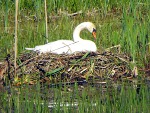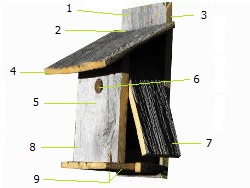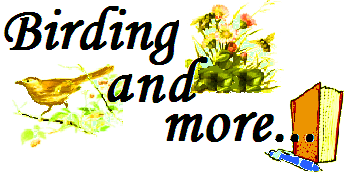 Newsletter
Newsletter
2010
/ Issue 9
IN THIS ISSUE: HOW TO PHOTOGRAPH WILD BIRDS - Part 1
Most of you know about my passion for bird photography. It's a hobby that brings me a lot of pleasure and satisfaction, and also provides a load of challenges. I've been at it a few years now, and I've learned a lot. In the next few issues of our newsletter, I will pass along some of the tips and tricks that I've learned.
Birds are everywhere, but photographing them can be a little bit like nailing jelly to a tree. It takes patience, persistence, and planning.
Let's start with the
basics. Birds are great subjects. They all look great and nature
provides phenomenal backdrops for our pictures. Having said that, birds
are timid, fidgety, and often difficult to locate. They are also
relatively small. So the first rule of getting good bird photos is to
GET CLOSE
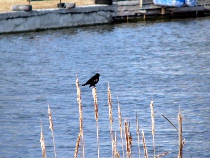
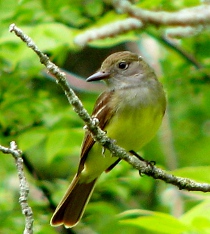
1. Wear camouflaged clothing and try to blend in with your surroundings.
Hiding in dense foliage near an area of high activity works well.
2. Move slowly and quietly and try to keep a tree trunk or dense bush
between you and your subject bird. Also, try not to make any quick jerky
movements. Raise your camera to your eye slowly and smoothly.
3. Use a portable blind in situations where there is no natural shelter.
4. Use a telephoto lens on your camera that can get you close up from a
distance.
5. Wear rubber boots so you can walk through wet muddy places if that's
what's necessary to get close to where the birds are.
Next issue: HOW TO COMPOSE A GREAT IMAGE
READERS' PHOTOS
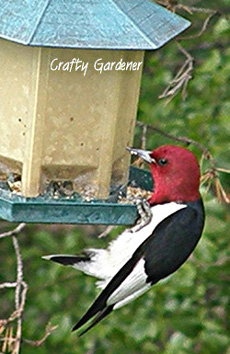
Red-headed
Woodpecker
taken by Linda
G aka Crafty Gardener
After
reading about the Red-headed Woodpecker that I spotted recently at
Prince Edward Point, Linda sent us this terrific photo of one that had
passed through her garden a couple of years ago. Not your typical yard
bird!
BTW -
Linda has a great
website:
http://www.craftygardener.ca/
***********************
The Readers
Patch is
a space for your photos, stories, and/or comments.
Send anything
you'd like to share with us to: newsletter@birdingandmore.com
BIRD WORD
SCRAMBLE
See if you can unscramble these weird phrases to
spell the names of
four common birds.
GIRLS TAN _ _ _ _ _ _
_ _
U SWAM TEN _ _ _ _ _ _ _ _
ONE PIG _ _ _ _ _ _
YULE JAB _ _ _ _ _ _ _
Many new posts have been added to the Birding and more blog.
New Icons/buttons have been added to the Other Stuff section of the main page.
Check out our Garden Bird List to see the surprising newest addition.
SWAN'S NEST IN TRENTON
On the east side of '2nd Dug Hill Road'
200 metres north of County Road 33
there is a pond where a pair of
Mute Swans have built their nest.
FEATURES OF A
GOOD NESTING BOX
Nesting boxes should be safe and
secure. They should also be durable and easy to clean.
Here are some guidelines to follow whether you plan to buy or build.
1. Should be made of untreated wood.
2. Roof should fit into a slot in the back to prevent water from running
down into the box.
3. Thick (3/4") walls.
4. Extended sloped roof to protect from predators and the elements.
5. No perches that can aid predators. This will also discourage House
Sparrows.
6. Entrance hole properly sized for intended species of bird.
7. Easy access for cleaning.
8. Sturdy construction.
9. Drainage holes.
I mentioned the several different shrubs we have planted around our backyard in an earlier Newsletter and all of them are coming along nicely. The Honeysuckles are in full bloom
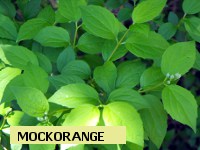 and the Chokeberry and Bridalwreath Spirea are also blossoming now. The
Mockorange has a number of small flower buds (first time so I'm quite
excited!) and the Hydrangeas and Nannyberries are also showing numerous
buds. Even the two Holly bushes have miniscule flowers so hopefully one
of them will develop berries. The Butterfly Bush is slower this year and
only has a few shoots coming up from the base so I'll be
and the Chokeberry and Bridalwreath Spirea are also blossoming now. The
Mockorange has a number of small flower buds (first time so I'm quite
excited!) and the Hydrangeas and Nannyberries are also showing numerous
buds. Even the two Holly bushes have miniscule flowers so hopefully one
of them will develop berries. The Butterfly Bush is slower this year and
only has a few shoots coming up from the base so I'll be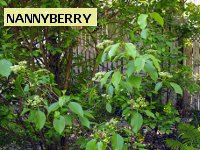 watching it carefully – I hope it's not a shrub that will need to be
replaced every couple of years!
watching it carefully – I hope it's not a shrub that will need to be
replaced every couple of years!I want to plant three more shrubs this year so I've been going through my “Trees & Shrubs” book and have added a couple of new choices to my long-standing “heart's desire”... I have wanted a Highbush Cranberry (also called American Cranberrybush) since the first garden I ever planted but it's either not commonly stocked in the garden nurseries or I've found others on my list more easily, and it had to wait for another year. Well, this is its year and I intend to start looking early and persevere until I find it! The main reason I want this shrub is for the berries it produces (for the birds of course) and hope that they stay on the shrub through the fall and into the winter. Obviously, if they are eaten up sooner rather than later, that's okay too! Another shrub I'd like to plant this year is an Azalea, if I can find a species that is hardy enough for Zone 5 winters. I have a partially shady spot that would look nice with a flowering shrub, next to the hedge, and apparently Azaleas attract hummingbirds too. And then, just for the bright colour, I'd like to plant a Shrubby St. Johnswort in a fairly sunny location.
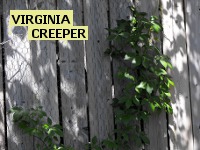 These
two additions are not carved in stone and if I don't find them, or they
aren't really suitable, I'll choose something else along the same line
and let you know!
These
two additions are not carved in stone and if I don't find them, or they
aren't really suitable, I'll choose something else along the same line
and let you know!Last but not least, we want to add a couple of Clematis vines along one fence and Garry has requested a couple of Wild Grape vines to complement our Honeysuckle vine and Virginia Creepers along the other fence.
It's so exciting to plan and dream but even more so, to watch your dreams come to fruition and that's how we feel about our backyard!
If you liked our newsletter
please pass it along to your friends and family.
Subscriptions are free! Just send an
email to: newsletter@birdingandmore.com
Copyright © 2010 Garry Kirsch www.birdingandmore.com
If you wish to cancel your subscription send an email to unsubscribe@birdingandmore.com
